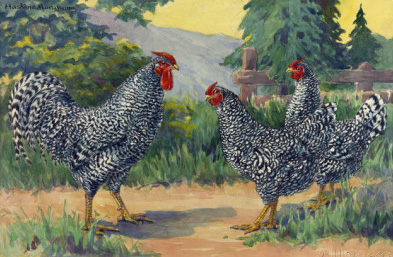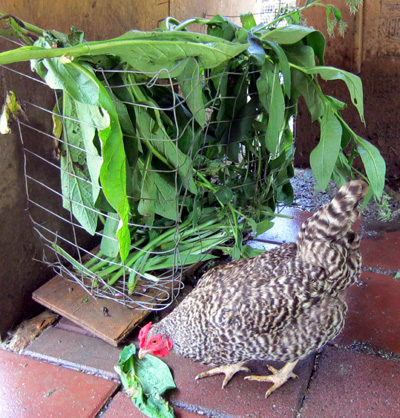
|
Physical
Characteristics
The Dominique
chicken is a medium-sized, black- and white-barred, cuckoo-patterned bird.
The pattern is called barring or hawk coloring. It makes the Dominique less
visible to predators.
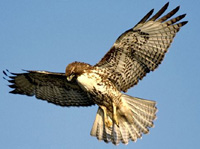 Plymouth Rock, Barred Rock or Barred Plymouth Rock chickens look similar
to Dominiques. Dominiques have staggered, irregular barring whereas Barred
Rocks have crisp, parallel barring.
Plymouth Rock, Barred Rock or Barred Plymouth Rock chickens look similar
to Dominiques. Dominiques have staggered, irregular barring whereas Barred
Rocks have crisp, parallel barring.
This photo is a hen eating comfrey. Then a photo of a hawk.
|
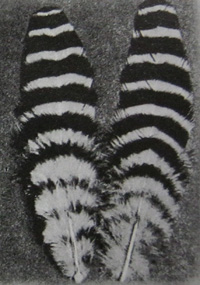 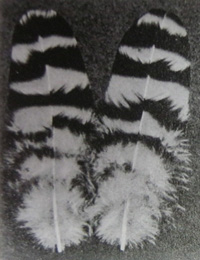
|
Feather
Barring
Dominque
colors are almost white (silver) and almost black (slate) whereas Barred
Rocks are pure white and black.
The white stripes on Dominiques are wider than the black stripes. Whereas
in Barred Rocks the two are the same width.
The photo to the far left is Barred Plymouth Rock feathers. The photo to
the right of it is Dominique feathers.
|
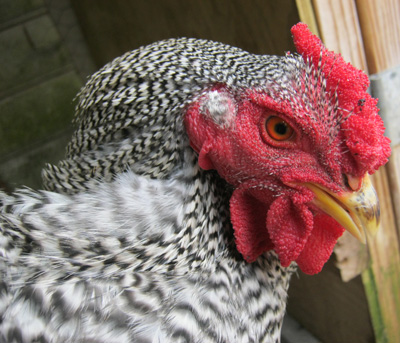
|
Traits
of Dominiques & Barred Rocks
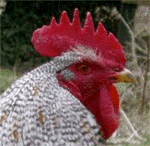 Dominique
fowl have a rose comb with a short upward curving spike. Barred Rocks have
a single comb. A rose comb is less likely to get frostbite in winter.
Dominique
fowl have a rose comb with a short upward curving spike. Barred Rocks have
a single comb. A rose comb is less likely to get frostbite in winter.
It is possible on rare occasions for Dominiques to have a single comb. Single
combs were somewhat common in the 1700s and 1800s. A rose comb is dominant
over the recessive single comb. A single comb in a Dominique is a sign of
good fertility.
Dominiques are smaller than Barred Rocks. Dominique roosters weigh 7-8 pounds
(7 is preferred); Barred Rock roosters weigh 7.5-9.5 pounds.
The photo to the left is a Dominique rooster. The photo right/top is a Barred
Rock rooster.
|
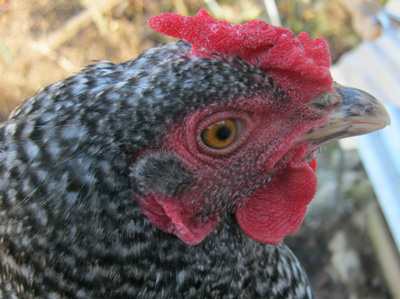
|
Dominique
Comb and Wattles
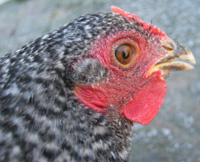 Dominiques
have True Rose combs. It is not large and beefy but compact, firm and straight
with a spike at the end.
Dominiques
have True Rose combs. It is not large and beefy but compact, firm and straight
with a spike at the end.
They have bright red wattles. (Wattles are under the chin.)
The photo to the left is a Dominique hen. The photo right/top is a 5-month-old
Dom pullet.
|
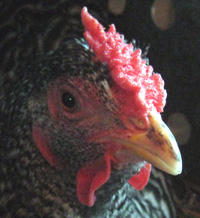
|
Dominique
Eyes and Beak
Their eyes
are reddish bay. The yellow beak is curved, strong and powerful.
The photo to the left is a Dominique hen.
"Thanks so much...we have really enjoyed the process of hatching Dominique eggs and hope to do it again. I would really love to hatch out some of your ducklings in the future as well." -Kate, Weaverville, North Carolina
|
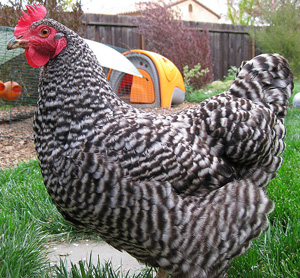
|
Plymouth
Barred Rock Hen
Barred Rock
chickens were created in the mid-1800s by combining Dominiques, Black Javas,
Cochins and maybe Dorkings and Malays. They are bigger and bulkier than
Dominiques.
In most crossbreeding the Dominique feather coloring/pattern is dominant.
Dominiques strengthen the weak constitution of Asiatic breeds.
The photo to the left is a Plymouth Barred Rock hen.
|
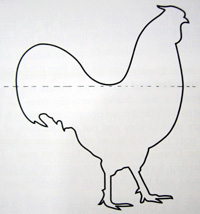
|
Graceful
Dominique Roosters
The Dominique
body is well filled out but not bulky, compact but not skinny looking.
The drawing to the left is a Dominique rooster showing the curve of his
back.
"From an aesthetic viewpoint, the Dominique male with a proper back
profile is a joy to behold." -Mark Fields, The American Dominique book,
1997
|
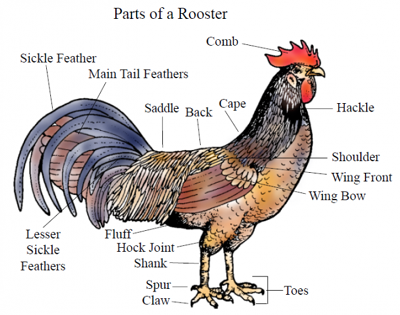
|
Parts
of a Rooster
Dominiques
have angular, erect bodies. They look stately. Barred Rocks are less upright
with a fuller body and neck.
Dominiques have long tails that are carried up high. They are full and flowing
with long sickle feathers. The sickle feathers are wider than Barred Rocks.
Barred Rocks have a lower tail with shorter feathers.
"I have hatched many eggs. But in no way an expert.
I love this breed. I want to raise a really good family of Dominiques. I'm
getting these eggs to improve my flock. I have a rooster that come from
your farm. I put him over some hatchery-grade Dom hens, and the offspring
was greatly improved." -Brian, Salem, South Carolina
|
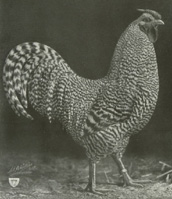 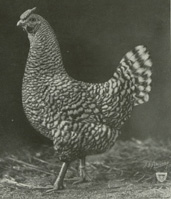
These drawings
are by A.O. Schilling, 1913.
|
Drawings
of Dominiques and Barred Plymouth Rocks
Dominiques
are to the left.
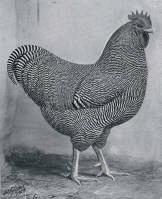
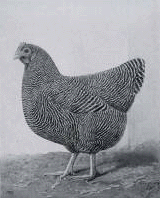
A Barred Rock rooster and hen are above. With these drawings you can easily
see the body shape differences between these 2 breeds.
|
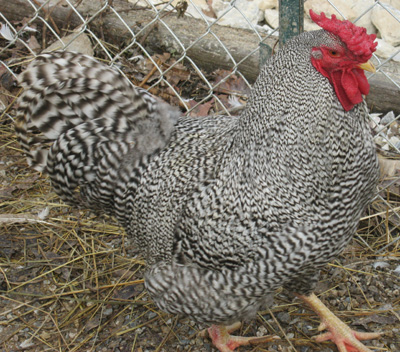 |
Proud
Looking Birds
The Dominique's
tightly arranged feathers (heavy plumage) keep the birds warm in winter.
Their firm yet soft feathers also provide luxurious stuffing for pillows,
comforters, and featherbeds.
Their legs and feet are deep yellow/orange. The males have a hint of pink
in their legs. Their beaks are short and stout.
There is a Bantam version of this breed.
This photo is a 7-month-old Dominique rooster.
|
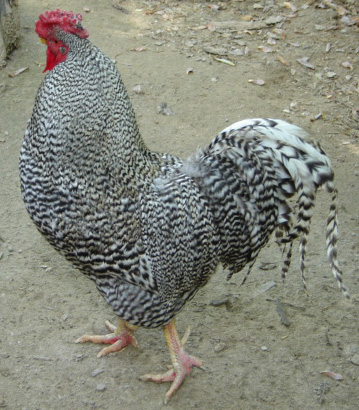 |
Regal
Tail Feathers in Males
Dominiques
carry their heads high up on well-arched, graceful necks. Their body is
broad and full with long and full tail feathers that are held the highest
of the American breeds.
"As breeds in the American class go, the Dominique is clearly the king when
it comes to tail." -The Dominiqiue Tail, Erik Nelsen, 1997
"There can be no doubt that an award-quality Dominique male is one of the
most handsome birds in the poultry world. The legs are actually a deep orange-yellow
with narrow vertical rows of red spots on the outside of the shanks. These
colors which provide a light reflecting quality, give the legs a live, eye-catching
appearance." -Mark Fields, The American Dominique book, 1997
This photo is an adult Dominique rooster with full tail feathers.
"These roosters are gorgeous! Love them."
-Caroline,
Kinta, Oklahoma
|
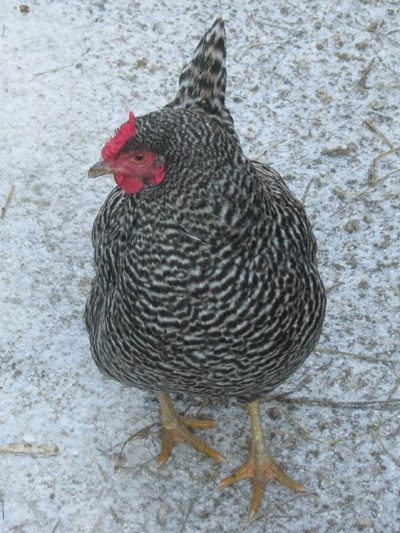 |
Dominique
Hen
Dominique
hens weigh 5 to 6.5 pounds (5 is preferred) compared to 6 to 7.5 pounds
for Barred Rock hens.
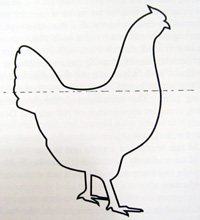 Dominique hens have a dish-shaped back whereas Barred Rock hens have an
evenly sloping back. Dominique hens have a longer neck and back so are more
refined looking than Barred Rocks.
Dominique hens have a dish-shaped back whereas Barred Rock hens have an
evenly sloping back. Dominique hens have a longer neck and back so are more
refined looking than Barred Rocks.
Dom hens have a plump, full breast with high tails.
"In style and general shape she is almost gamey with an ambitious carriage."
-F.L. Sewell, 1915
This photo is a Dominique hen taking a stroll in light snow.
|
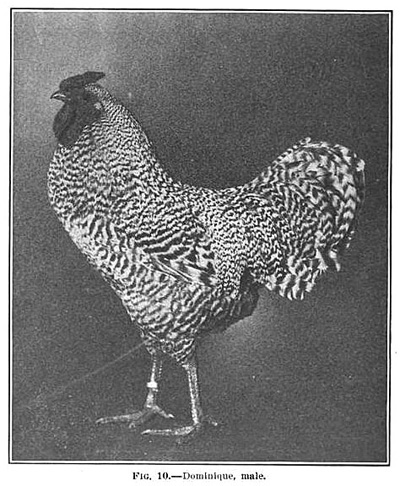 |
American
Dominique Male
"I was really happy to find your site as I did not want to buy from a big
hatchery. I have found the Dominique to be a really gentle breed so much
nicer than the Rhode Island Reds I had previously. I love the fact that
they are the first American breed and worth preserving." -Ailish, Dighton,
Massachusetts
"Thank you so much, i am very pleased with my chicks and hatch:) your
tips help tremendously, and i have recommended my friends to you as well:)"
-Gabriella, Bartow, Florida
"It is simply amazing that a breed as old as the Dominique has changed so
very little." -Mark Fields, The American Dominique book, 1997
This photo of a Dominique rooster was taken in 1919.
|
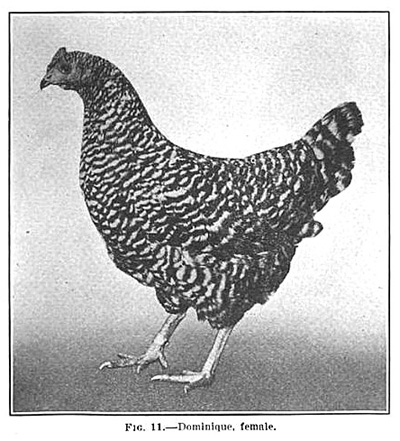 |
American
Dominique Female
"Just wanted to tell you what fun I am having with the new Dominique
girls. Sassy is acting like a lap cat. She actually lays down in my lap
and goes to sleep. My other girls that are friendly like to be held and
rubbed on their heads for a short time, but actually laying down and konking
out from the head rubs for 20 minutes is a first for me. I was the one that
had to wake her up and put her down! The other two hens are super friendly
also and love affection. This breed of chicken is just awesome!" -Lori,
Chesterfield, Virginia
This photo of a Dominique hen was taken in 1919.
|

 Plymouth Rock, Barred Rock or Barred Plymouth Rock chickens look similar
to Dominiques. Dominiques have staggered, irregular barring whereas Barred
Rocks have crisp, parallel barring.
Plymouth Rock, Barred Rock or Barred Plymouth Rock chickens look similar
to Dominiques. Dominiques have staggered, irregular barring whereas Barred
Rocks have crisp, parallel barring.



 Dominiques
have True Rose combs. It is not large and beefy but compact, firm and straight
with a spike at the end.
Dominiques
have True Rose combs. It is not large and beefy but compact, firm and straight
with a spike at the end. 







 Dominique hens have a dish-shaped back whereas Barred Rock hens have an
evenly sloping back. Dominique hens have a longer neck and back so are more
refined looking than Barred Rocks.
Dominique hens have a dish-shaped back whereas Barred Rock hens have an
evenly sloping back. Dominique hens have a longer neck and back so are more
refined looking than Barred Rocks.

